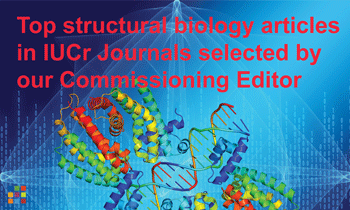issue contents
October 2023 issue

Cover illustration: The crystal structure of mouse ketohexokinase [Ebenhoch et al. (2023), Acta Cryst. D79, 871–880]. A molecular understanding of the proteins involved in fructose metabolism is essential for controlling the current spread of fructose-related obesity, diabetes and related adverse metabolic states in Western populations, and fructose catabolism starts with the phosphorylation of D-fructose to fructose 1-phosphate by ketohexokinase.
research papers
Crystal structures of human and mouse ketohexokinase both in unliganded states and in complex with a species- and isoform-selective ligand reveal a previously unrecognized hotspot for inhibitor design.
The heterodimeric coiled coil formed between human septins 14 and 7 is parallel and has nonstandard repeats and unusual helix-to-helix packing; it is metastable, which allows the transition to antiparallel homodimeric states believed to be involved in septin filament cross-linking.
PDB reference: metastable SEPT14–SEPT7 heterodimeric coiled coil, 8sjj
The crystal structure of 4-amino-4-deoxychorismate synthase (ADCS), which is composed of a PabA–PabB complex, was determined for the first time. This study provides structural insights into the allosteric pathway of ADCS.
Open  access
access
 access
accessSingle-step intensity-based hierarchical clustering is demonstrated to allow the detection of structural polymorphs in diffraction data sets obtained from multiple crystals. By splitting data sets collected using a continuous helical scheme into several chunks, both inter-crystal and intra-crystal polymorphs can successfully be analyzed.
Open  access
access
 access
accessUsing a 1TEL–CMG2-vWa construct, evidence is provided to support limiting the flexibility of linkers between TELSAM and proteins of interest and considering retaining polyhistidine purification tags in TELSAM-fusion constructs. The phenomenon of TELSAM-polymer flipping is also identified and a correction strategy is developed.
Open  access
access
 access
accessAn improved design of an all-polymer microfluidic `chip' for fixed-target serial crystallography is presented that can easily be fabricated in-house, is inexpensive and is highly modifiable to meet broad user needs for room-temperature serial crystallography at both synchrotron and XFEL light sources.
obituaries
Open  access
access
 access
access
 journal menu
journal menu

























